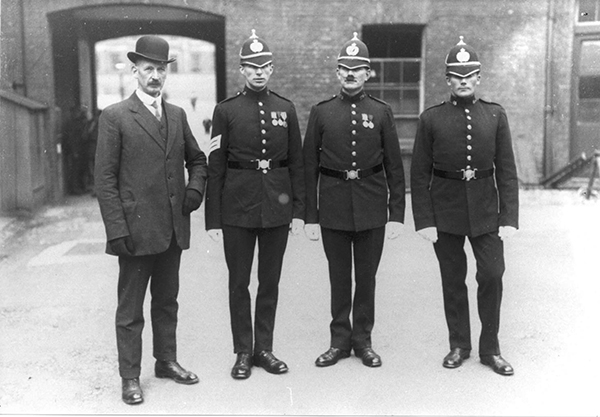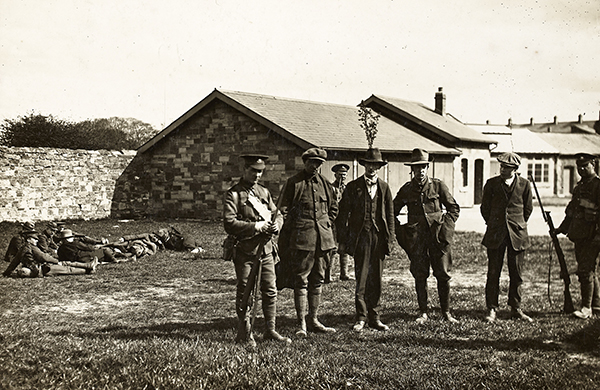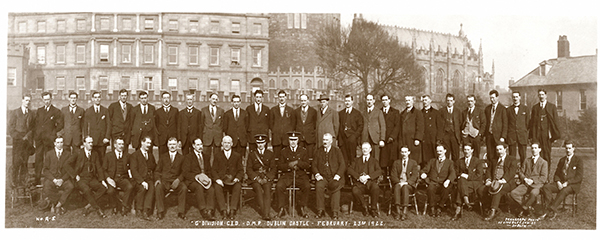‘Oh God, what did I do to deserve this?’
Published in Features, Issue 5 (September/October 2016), Revolutionary Period 1912-23, Volume 24THE LIFE AND DEATH OF DETECTIVE SERGEANT JOHN BARTON
By Padraig Yeates
If he died today in the line of duty Detective Sergeant John Barton of the Dublin Metropolitan Police would probably be declared a national hero. The Irish Times editorial of 1 December 1919 proclaimed him ‘one of the bravest, most vigilant, and most intelligent defenders’ of the city’s peace. The Irish Independent said that ‘Sergeant Barton seemed possessed of an instinct for tracking down criminals and his name alone was sufficient to inspire terror in the hearts of evil doers’.
Obviously it was not sufficient to deter the IRA’s director of intelligence Michael Collins, although he designated no less than three groups of Volunteers to carry out the task. On 29 November 1919, all three converged on Barton when he was only yards from the safety of the new Central Police Station on Great Brunswick (now Pearse) Street. The fatal shot was probably fired by Seán Treacy, who had led the Soloheadbeg ambush in which RIC Constables James McDonnell and Patrick O’Connell were killed, sparking the War of Independence the previous January. Barton was hit at such close range that there were scorch-marks on his clothes.
He managed to draw his revolver and fire one round before exclaiming, ‘Oh God, what did I do to deserve this?’ and collapsing on the ground. The question still preyed on his mind as a Dublin Fire Brigade ambulance took him to Mercer’s Hospital. He said to the crew, ‘They have done for me. God forgive me. What did I do?’
Background
John Barton was born in April 1880 into a farming background at Firies, Co. Kerry. He joined the Dublin Metropolitan Police in February 1903, and at six feet four and a quarter inches he certainly met the DMP criteria of being physically impressive, although he walked with a slight stoop. Barton was one of the best-known members of B Division, which was based in the south-east quadrant of the inner city. He only transferred to the detective or G Division of the DMP on 10 October 1919, less than seven weeks before he was killed. He was the fourth DMP member, and third G Division detective, to be killed in the War of Independence.
He was, however, well known and feared in labour as well as republican circles long before that. As Irish Citizen Army veteran Frank Robbins said, ‘He did more than his duty’. Barton arrested over 40 people during the 1913 Lockout and helped apprehend a dozen workers involved in a Christmas Day fracas on City Quay when DMP Sergeant James Kiernan was thrown in the Liffey. One ITGWU member, Patrick Higgins, tracked down by Barton, was subsequently sentenced to ten years for his role in the affair. Such activities were not designed to make a policeman popular. Nor was his apprehension earlier that month of a ‘chocolate gang’. John Kearney, aged eleven, was sentenced to a month in Summerhill, and Michael Donegan, aged twelve, to five years in Glencree for larceny of chocolate. John Kelly, aged thirteen, and Joseph Grimes, aged eleven, were put on £5 bail and eighteen months’ probation each.
Role in 1916
It was in 1916 that Barton gained real notoriety. He ignored orders to remain in barracks during the Easter Rising. Undeterred by the fatal shootings of three colleagues and the wounding of seven others, he prowled the streets apprehending rebels and looters. After the surrender he went to Richmond Barracks to assist G Division detectives in identifying leading rebels. Presumably he was working as a ‘buckshee’ detective on his own time in the hope of a transfer to the detective division. IRB member Seán Murphy later testified that it was Barton who picked out Seán MacDermott, saying, ‘Sorry, Seán, but you can’t get away that easy. There will be six for you in the morning, I think’—a passing reference to the number of soldiers who made up a firing squad.
Frank Robbins recalled Barton stopping in front of Joseph Connolly to tell him that his brother Seán had been killed in the Rising. When Joseph replied, ‘He died for his country’, Barton retorted that ‘He was a disgrace to his country’. When he saw Michael Donnelly, another ICA member and an ITGWU activist, Barton, in a reference to the Lockout, asked, ‘Do you remember the day you laughed at me going down the quays?’ Donnelly answered, ‘Hasn’t the cat leave to laugh at the king?’ Barton growled ‘I suppose so’, and passed on. Robbins later accused Barton of badgering one vulnerable ICA prisoner so much that the man attempted suicide.
Other detectives participated in the identification process that day but it was Daniel Hoey and John Barton who left the most lasting impression. Over 30 years later Robert Holland, a member of Na Fianna, remembered the pair ‘as they cynically walked slowly down along the hall with a sneer on their faces’. Barton used a walking stick to identify important figures to the military, Hoey an umbrella.
Nor did these activities distract Barton from his normal police duties. A major anomaly of the Rising is that, although the bulk of the looting in Easter Week occurred north of the Liffey, most of those arrested for illegal possession of goods lived south of the river. Of the 425 people convicted of this offence in the weeks after the Rising 296 were arrested by John Barton, or Constable 37B, as he is listed in the DMP Prisoners Books. This included most of the women arrested. They comprised 58% of all those sentenced in the police magistrates’ courts in May 1916 and 27% of those convicted in June. Barton had single-handedly transformed the criminal profile of Dublin from one in which men always constituted the vast majority of culprits to one in which they were supplanted by women, albeit only for a few weeks.
June 1916 demonstration
He returned to the fray on 18 June, when the first public demonstration took place in support of the rebels. It began when a group of 400 ‘girls’ carrying a ‘republican flag’ gathered outside Christ Church Cathedral following requiem Masses at the Church of the Immaculate Conception on Merchant’s Quay for Tom Clarke and at St Mary of the Angels on Church Street for Eamonn Ceannt. Both churches were in the charge of the Franciscans, the most sympathetic religious order in the city to the republican cause.
The ‘girls’ accumulated a crowd of 2,000 people as they advanced down Dame Street towards O’Connell Street. They booed the British sentries outside Dublin Castle and the Bank of Ireland in College Green before being intercepted by the DMP outside the Ballast Office. The police were determined to prevent them from crossing the river. Trouble erupted when the police attempted to seize the flag. Tram destination boards and Volunteers’ Dependants’ Fund boxes were among the missiles used to counter police batons. Seven young men and three women were arrested and charged with ‘Doing an act likely to prejudice the Defence of the Realm; Assaulting the Police etc.’ Although the chief police magistrate, E.G. Swifte, decided to deal with the cases under the Public Order Acts rather than employ the more draconian penalties contained in the Defence of the Realm Act, the accused were unapologetic. Two of the men, Percy Forrester and John Halpin, freely admitted striking policemen but became indignant at the suggestion that they kicked any. Catherine Bolger admitted not only kicking a policeman but also hitting another in the face and calling them all ‘Saxon curs and Saxon dogs’. At least two of the defendants, sixteen-year-old Denis Fitzpatrick and 22-year-old Christina Caffrey, had taken part in the Rising but had evaded arrest. Fitzpatrick was let off with a caution and Caffrey was fined 40 shillings.

Above: Sergeant John Barton (second from the left) in Dublin Castle on 2 February 1917 after he had been awarded his first King’s Police Medal (third medal on the right) for his services in the Easter Rising, when he disregarded orders to remain in barracks. He was awarded a second in early 1918 for his services in 1917, the only member of the DMP to win two. (Garda Stephen Moore)
The fact that Fitzpatrick and Caffrey were apparently ‘unknown to the police’ underscores the woefully inadequate state of DMP intelligence and suggests that the G Division was not as omniscient as it is sometimes portrayed. In fact, only a minority of members were involved in the detection of political as opposed to ordinary crime. Curiously, the two policemen most badly injured in the fracas outside the Ballast Office were Constables Barton and Henry Kells. Kells would soon be acting as another ‘buckshee detective’ in the hope of promotion to G Division. Unlike Barton, he did not achieve his ambition. In fact, he did not long outlive Barton, being shot dead on 24 April 1920 at the junction of Camden Street and Pleasant Street while operating in plain clothes. His last words, if any, are unrecorded.

Above: Rebel prisoners under guard in Richmond Barracks, May 1916. Barton played a leading role in identifying the leaders. (NLI)
Awarded King’s Police Medal
On 2 February 1917 Barton was awarded the King’s Police Medal (KPM) ‘for conspicuous gallantry and exceptional ability and devotion to duty during the past year’. This was the highest award a police officer could receive. According to the statement issued to the newspapers, it was in recognition of Barton’s being
‘… instrumental in the detection and apprehension of a very large number of criminals. During the first night of the rebellion he arrested at great personal risk twenty-seven persons who were looting in the vicinity of O’Connell Bridge, which was dominated by rebel fire, and on the same night, with the assistance of another officer, he arrested two armed men who were carrying a large quantity of ammunition.’

Above: DMP Commissioner Lt Col. Sir Walter Edgeworth Johnstone (with stick) and Assistant Commissioner Denis Barrett (to his right) with 39 members of the G Division, shortly after they were disbanded on 1 February 1922. Four of the eleven DMP members killed in the War of Independence were G Division detectives. Contrary to popular belief, most were ordinary detectives and unwilling recruits to political work. (Superintendent Brendan Connolly)
He was promoted to sergeant on the same day, which saw his pay rise from £1 14s 8d a week to £2 0s 8d, and it would rise again to £2 12s 8d on his transfer to G Division on 10 October 1919. These very substantial increases totalled over 50%, but they hardly explain his dedication to duty at a time when many members of the DMP were engaged in a retreat from the increasingly hostile streets. Between 1913 and 1919 the number of arrests carried out by the DMP fell from 11,065 to 4,394, summonses served fell from 28,334 to 16,261 and assaults on constables fell from 338 to 51. Some G Division detectives, such as Eamon Broy and David Neligan, became double agents for Collins, as did members of the uniform branch such as Joe Kavanagh and Maurice Aherne. In fact, much of the information leading to the assassination of G Division members came from their fellow officers. Far from following their example, Barton received a bar to his KPM in 1918 in recognition of his continuing exemplary conduct, including the dramatic arrest of an armed Boer officer for desertion in 1917. He was the only member of the DMP to receive two KPMs.
Accumulated enemies
Barton remained an aberration, accumulating enemies as he went. Michael Noyk, who was a leading defence lawyer for republicans in the British courts, recalled that his very first case was representing a man accused by Barton of larceny of a military service rifle. When Noyk met Barton in the Empire Music Hall on Dame Street later he twitted him about losing the case, asking ‘Did you ever get the gun?’ Barton snapped, ‘I think you know more about it than I do’. A newly recruited teenager to Collins’s intelligence operation, Charlie Dalton, who was to have a somewhat chequered career of his own, said that Barton
‘… was held in the highest esteem by the publicans, pawnbrokers and other commercial men, due to the fact that he had established a unique method in the tracing of petty larceny and illegal pawning of stolen goods. In carrying out his routine police duties, he had many newsvendors and minor thieves of the pick-pocket variety in his power, and he utilised this type of informer for checking on the movements of prominent wanted volunteers.’
Frank Henderson, who was a 1916 veteran and commandant of the 2nd Battalion in Dublin, described ‘the well-known Johnny Barton’ as
‘an efficient criminal detective … who had only undertaken “political work” after the Republican Government had begun to exact the death penalty on enemy intelligence personnel. Barton was warned when he commenced his spying but did not heed the notices sent to him.’
Why Barton pursued a career path that meant almost certain death will probably never be known. A single man with no obvious interests outside the job, he was single-minded in pursuit of the enemy, oblivious to the rapidly changing political climate.
When nineteen-year-old Vinnie Byrne was asked by Mick McDonnell, the head of Collins’s newly organised ‘squad’, ‘Would you shoot a man, Byrne?’, the young carpenter replied, ‘It’s all according who he was’. When McDonnell said, ‘What about Johnny Barton?’, Byrne said, ‘Oh, I wouldn’t mind’. Barton had earlier raided Byrne’s home. After finishing work that day, he was one of the gunmen who cornered Barton at 6pm on College Street and left him to die wondering what he had done to deserve such a fate. To some he was a hero; to others, such as Fianna boy Robert Holland who remembered him from Richmond Barracks, Barton was ‘the very scum that kept us in British bondage’.
Padraig Yeates is the author of A city in civil war: Dublin 1921–4 (Gill & Macmillan, 2015).
FURTHER READING
DMP Prisoners Books: http://digital.ucd.ie/view/ucdlib:43947.
J. Herlihy, The Dublin Metropolitan Police (Dublin, 2001).
Stephen Moore, Pearse Street, 100: a history of Pearse Street Station (Dublin, 2015).
P. Yeates, A city in wartime: Dublin 1916–1918 (Dublin, 2011).
















